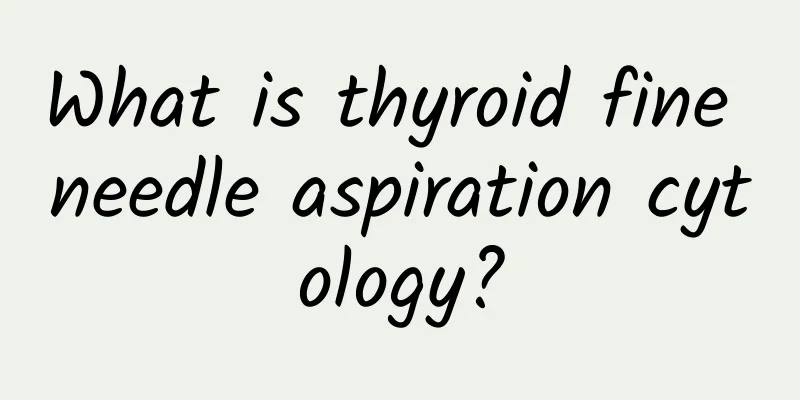What is thyroid fine needle aspiration cytology?

|
Author: Zhang Jinxia, Chief Physician, Peking University Shougang Hospital Reviewer: Wu Xueyan, Chief Physician, Peking Union Medical College Hospital There are two types of puncture needles used clinically, one is a thick needle and the other is a thin needle. The hole of the coarse needle puncture is relatively large, and there is a small blade inside the hole. During the puncture process, a piece of tissue is actually cut off. The cut tissue is sent to the pathology department for examination. What the doctor sees is a piece of meat. This is called coarse needle puncture, and it has a tissue structure. Because the thyroid gland is rich in blood vessels, the risk of bleeding is relatively high with a coarse needle puncture, so fine needle puncture is usually used. Fine needle puncture is actually similar to a blood draw needle, with a very thin needle hole that can only accommodate two or three cells, so what is actually drawn is cells. Therefore, fine needle puncture is strictly called fine needle aspiration cytology of the thyroid gland. Figure 1 Original copyright image, no permission to reprint Generally speaking, after a thyroid nodule is detected, a puncture examination is generally not recommended for nodules smaller than 1 cm if there are no malignant indications. However, for nodules larger than 1 cm, if there are malignant indications, such as gravel-like calcifications found on B-ultrasound, or unclear nodule boundaries extending to the surrounding like burrs, or a solid tumor with low echoes in the middle, or rich blood vessels in the nodule, a puncture examination is required. Of course, if the patient with thyroid nodules has a history of radiation exposure and contact; or has a family history of thyroid cancer; or if the tumor is small but there are signs of metastasis to the cervical lymph nodes, a puncture examination should also be performed in these cases. In addition, if the patient has hypercalcitoninemia, a puncture examination should be performed to confirm the diagnosis, because elevated calcitonin levels are a biological marker for medullary thyroid carcinoma. However, we must know that for female patients, puncture should be avoided during menstruation; in addition, for patients with abnormal coagulation function, or local skin infection at the puncture site, or respiratory infection symptoms such as cough and fever, these patients should adjust their bodies to normal before puncture. Another reason is that the tumor may be of a special type and close to a large blood vessel. Doctors may think that the risk of bleeding from puncture is relatively high, so they may not recommend puncture, but recommend direct surgical removal. However, generally speaking, even if there is bleeding during puncture under ultrasound guidance, because the human body's blood vessels have a certain ability to contract and contract quickly, and after puncture, the dressing is pressed, so severe bleeding generally does not occur. Before puncture, the patient can move normally, but be careful not to eat too much. During the puncture, the patient lies flat, removes the pillow, and tilts his head back to fully expose the thyroid gland. After positioning with ultrasound, 2-3 needles are usually drawn for each nodule. Cooperate with the doctor during the puncture. It is best not to talk, swallow, or cough. After the blood is drawn out, there is a glass slide for pathology, and the blood is smeared on the glass slide for cytological examination. At the same time, we know that sometimes there is blood in the syringe, and the cells drawn out often adhere to the tube wall and the inside of the needle, so the tube wall and the needle need to be flushed, and the flushing fluid is then fixed in the fixative, so that a cell wax block can be made, or a genetic test can be performed. The entire puncture process takes about 10-15 minutes. The patient will experience mild pain, but most patients can tolerate it, so anesthesia is generally not required. Figure 2 Original copyright image, no permission to reprint The fine needle puncture report can usually be obtained in about two days. If a cell wax block or genetic test is required, the test report can be obtained in about 3-5 days. You can speak normally after the puncture, but do not do strenuous exercise. It is best to take a shower after 24 hours. You can eat some warm and cool food when eating, but avoid eating too hot food. In addition, after puncture, the patient may feel slight pain, and generally use dressing to press and stop bleeding for 10-15 minutes. If there is no discomfort in the needle hole, the dressing can be removed. However, if you find that the lump in your neck becomes larger after the puncture and you feel some discomfort, you should seek medical attention immediately to avoid serious complications. |
<<: Thyroid puncture biopsy pathology report - interpretation of common terms!
>>: After a brain injury, how can we gradually regain lost motor skills?
Recommend
How big is the follicle usually when it is released?
In life, many friends are very concerned about th...
Is it good to use pull bait to catch crucian carp in late autumn and winter? How to open the bait when fishing crucian carp in low temperature?
The pull bait is very soft and can be easily suck...
What are the causes of breast cysts?
Breast cysts are becoming more and more common am...
How can I have colon cancer at such a young age?
In everyone's impression, colorectal cancer u...
Will myopia get worse after adulthood? If you don't correct these points, you may develop severe myopia
Reviewer of this article: Xu Qibin, associate chi...
How many days after menstruation does it take to test for pregnancy
Under normal circumstances, menstruation is very ...
The difference between pregnancy and menstrual symptoms
We all know that once a woman becomes pregnant, s...
Why do you take off your underwear before going to bed?
Many women do not take off their underwear when t...
Nursing care for patients with pelvic fractures
Due to external factors, the integrity of the bon...
Can I have IVF if I have habitual miscarriage?
Some women are troubled by habitual miscarriage. ...
Brown discharge during pregnancy
Women's lower body produces a secretion, usua...
What color should the leucorrhea be?
It is well known that leucorrhea can be used to j...
Is it true that all the Spring Festival movies have been withdrawn? When will the 2020 Spring Festival movies be postponed?
As the number of confirmed cases of novel coronav...
Effects of taking progesterone after ovulation
For many women who are preparing for pregnancy, d...
Will women have stringy vaginal discharge when they ovulate?
Women ovulate once a month, and the specific ovul...









